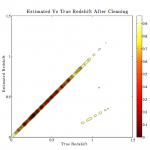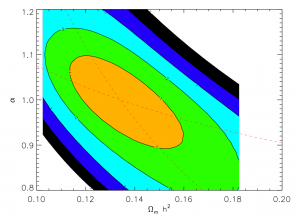Galaxies
Galaxies serve as distant laboratories for astrophysicists studying how structure has formed in the Universe. For cosmologists, on the other hand, galaxies are fundamental probes of the structure of the Universe itself. In order to exploit these probes it necessary to determine how far away they and how they are distributed across the sky. The CosmoStat team has worked on developing tools to solve precisely these two problems.
Spectroscopic Redshift Estimation
The ability to accurately and reliably determine the distance of galaxies is of fundamental importance to cosmology. This, however, can be quite challenging even with galaxy spectra. One of the main problems being the reliance on human intervention.

The CosmoStat team have developed a fully automated redshift estimation algorithm called Darth Fader. This algorithm is based on wavelet decomposition of galaxy spectroscopic data instead of the traditional Fourier decomposition. Wavelets are localised both in real and transformed domain, and as such, a choice of few main coefficients encapsulates most information of the non-periodic features of galactic spectra.
Results of running this algorithm on simulated galaxy spectra demonstrated that is both extremely robust and highly competitive.
Galaxy Clustering
The statistics of galaxy distributions are powerful constraints on cosmological parameters. Using measures like the two point correlation function (2PCF), which counts pairs of galaxies at different scales, can give us better estimates of the amount of matter in the Universe and offer insights into the nature of dark energy.
Members of CosmoStat have been involved in various projects regarding galaxy clustering statistics such as:
- Investigating the biases introduced by 2PCF estimators using data from the 7th data release of the Sloan Digital Sky Survey (SDSS DR7). [1]
- Designing a new wavelet based approach for detecting features in Baryon Acoustic Oscillations (BAO). [2][3][4]
- Proposing new methods to multiscale morphological properties of galaxy distributions and testing this approach on data from the 2dF Galaxy Redshift Survey. [5]
- Studying the evolution of galaxy properties in data from Canada France Hawaii Telescope Lensing Survey (CFHTLS). [6]

